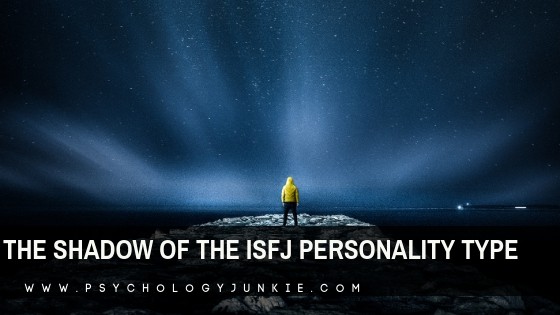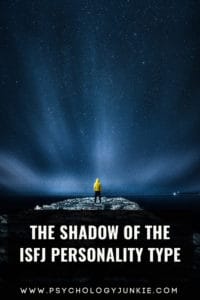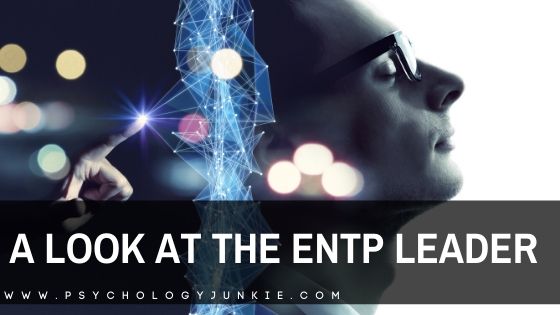The Shadow Functions of the ISFJ Personality Type
Do you want to get a deeper look at both the strengths and hidden weaknesses of your personality type? Are you tired of hearing all the same old basic things about your type and want a little more depth? Today we’re going to explore the 8-function model of the ISFJ personality type. Most online articles about ISFJs will focus on their basic preferences (Introvert/Sensor/Feeler/Judger) or even their primary function stack (Si/Fe/Ti/Ne). Today we’re going to get a look at how ISFJs use EVERY function in their typological stack. This might be fun and also a little unsettling sometimes! Let’s dive right in!
Not sure what your personality type is? Take our new personality questionnaire!

Table of contents
Estimated reading time: 13 minutes
What are the Shadow Functions?
Each of the 16 Myers-Briggs® personality types has a function “stack”. What most type descriptions will focus on are the four primary functions found in one’s personality type. For an ISFJ these functions would be as follows:
Dominant Function: Introverted Sensing (Si)
Auxiliary Function: Extraverted Feeling (Fe)
Tertiary Function: Introverted Thinking (Ti)
Inferior Function: Extraverted Intuition (Ne)
Does this mean that ISFJs never use Extraverted Sensing? Absolutely not! If they didn’t they would have a really hard time reacting to anything in their environment, and getting anything done would be near impossible. We all use ALL of the cognitive functions. We just prefer and process life through some functions over others. Here is a look at the ISFJ’s specific shadow functions:
The ISFJ Shadow Functions:
Opposing Role: Extraverted Sensing (Se)
Critical Parent/Senex: Introverted Feeling (Fi)
Trickster: Extraverted Thinking (Te)
Demon: Introverted Intuition (Ni)
All these names can sound kind of “woo-woo” and ominous, but don’t worry. You’ll understand why these function placements have these titles as we go along. Shadow functions can show up in both positive and negative ways. Our primary functions are accepted into our ego. We see them as part of us. We recognize them, they come naturally, and we’re more likely to use them with a maturity that we struggle with when using our shadow functions. Our shadow functions feel “other” to us. They’re a part of ourselves that we don’t necessarily relate to. This means that we tend to use them without even realizing we’re doing it. The shadow functions tend to be blind spots and the source of many of our weaknesses and projections. They can also be areas that cause us to grow and to make better decisions and judgments.
A Little Background:
The 8-function type model comes from the work and analysis of John Beebe and Mark Hunziker. Dr. John Beebe, M.D. is a Jungian analyst, editor of the San Francisco Jung Library Journal, co-editor of the Journal of Analytical Psychology, and author of Energies and Patterns in Psychological Type: The Reservoir of Consciousness. Beebe wanted to understand how our non-preferred functions showed up in our lives. He felt that there had to be more to an individual than just the four basic primary functions, and he noticed patterns in his client’s behaviors that matched up with specific Jungian archetypes. While Isabel Briggs Myers focused primarily on the dichotomies (I/E, S/N, T/F, J/P) and the primary function stack, she didn’t delve deeply into the less-preferred functions. Beebe was sure that Jung had more to say about the unconscious and spent many years studying how these functions played out in himself and the people around him. Mark Hunziker, another expert in 8-function type theory, is a consultant for the Association of Psychological Type, and author of Depth Typology.
This article contains affiliate links. I only recommend products I truly believe in.
A Brief Look at the ISFJs Four Primary Functions:
Hero Function: Introverted Sensing (Si)
ISFJs have a profound knowledge of where they’ve come from and the various life experiences they’ve gathered along the way. They are constantly collecting lessons and impressions that they can apply to present and future situations. When ISFJs feel the most confident and sure of their direction they are often using the energy of Si. Si gives them an awareness of inner-body sensations and comfort, which is one of the reasons why ISFJs tend to have highly-nuanced senses of taste, as well as an innate sense of what will give them (and others) comfort. Si also tends to make ISFJs realistic and grounded in the world around them. They often enjoy working with their hands, being in nature, creating beautiful settings or capturing memorable experiences. They try to create a sense of consistency and stability in their lives and the lives of their loved ones. Creating meaningful rituals and traditions throughout their lives helps them to feel a sense of peace and meaning.
Mother/Father Function: Extraverted Feeling (Fe)
ISFJs protect and nurture others through the use of this function. Fe helps ISFJs to tune into the emotional and physical needs of the people around them. Natural hosts, ISFJs easily recognize shared values, expectations, and harmony or lack thereof. They often feel responsible for the overall mood of the room they are in, and they have a knack for putting people at ease in their presence. Sometimes they do this through providing an act of service, other times they craft the perfectly timed self-deprecating joke to ease tension or connect with someone. ISFJs tend to be strong believers in the Golden rule: “Do unto others as you would have them do unto you.”
Eternal Child Function: Introverted Thinking (Ti)
When ISFJs are relaxed and playful they tend to enjoy thinking-oriented activities. Introverted Thinking is a decision-making process that focuses on gathering and sorting out impersonal data to find logical solutions and intricacies. It is highly-focused on accuracy and finding logical connections or disconnects. ISFJs enjoy exploring new information and seeing where it fits in with their accumulated knowledge. Learning frameworks, theories, and models can be mentally stimulating and exhilarating for them. They also tend to be quick to notice logical inconsistencies, but they may not immediately point them out for fear of offending someone. Because Ti is not as advanced for the ISFJ as Si or Fe they can sometimes use it in immature ways. They may obsess, over-analyze, and become pushy about their idea of truth. During stress they can be more critical than usual, pointing out nitty-gritty logical shortcomings of others without focusing on what’s important in the context of the moment.
Anima/Animus: Extraverted Intuition (Ne)
This function is also called the “aspiring” function. It feels like it should be an easy function to use, but it consistently trips people up. It’s also a function that tends to appear in daydreams. When we fantasize about being particularly good at something we often focus on excelling with this function. For ISFJs this function is filled by Extraverted Intuition or “Ne” for short. Ne is focused on abstract connections and possibilities. Ne-users (NPs) are quick to extrapolate hidden connections and relationships. They enjoy living spontaneously and brainstorming hypothetical possibilities. ISFJs might enjoy daydreaming about possibilities and hidden meanings, but they often don’t trust these for use in day-to-day life. They tend to dismiss tangential ideas and see them as a waste of time. They might be drawn to people who have a skill in this area because they naturally sense their deficiency here, but they feel more comfortable sticking with what they know rather than branching out into unknown, risky territory. The older and more mature ISFJs become the more they develop a skill for seeing interconnections, following uncertain possibilities, or trying things in new ways. This function can also show up during periods of extreme stress. When highly anxious, ISFJs can extrapolate numerous potential possibilities of how things could go wrong. They can also become concerned about potential dangers that are unlikely to occur.

The ISFJ Shadow Functions
The Opposing Role: Extraverted Sensing (Se)
Se is the antithesis to the ISFJ’s dominant function, Introverted Sensing (Si). Si focuses on inner sensations, stability, and preserving lessons and impressions from personal experience. Se focuses on outer-world experience, reacting spontaneously to the needs of the present, and trusting impulses and instincts. ISFJs tend to experience Se as an oppositional voice in their mind. It’s the passive-aggressive critic to their Si. It’s the inner voice that says, “Alright, so you’re doing it the way you’ve always done it again. Sooooo exciting. Don’t you want to try something new?” Or, “You see what’s happening right now, don’t you? Get out of your comfort zone and get involved!”
ISFJs can project oppositional behavior onto Se-users who aren’t even being oppositional. Because ISFJs tend to experience Se as an oppositional voice inside themselves, they can also believe that Se-users (SPs) are being oppositional when they aren’t. They may feel that SPs are overly-impulsive, irresponsible, or heedless to caution.
Oppositional Se isn’t always bad, however. Once ISFJs realize that this voice belongs to them, they can own it and realize that not all of its input is negative. They can pause when Se is expressed or experienced and think about which decision is the wisest. They can lose their bias against Se and see its positive uses (adaptability, flexibility, cleverness in crisis situations).
The Critical Parent/Senex: Introverted Feeling (Fi)
When ISFJs feel self-critical, limiting, or immobilizing (or behave this way to others) it is often triggered by the critical parent. Fi is the antithesis to the ISFJ’s mother/father function, Extraverted Feeling (Fe). Fe is focused on understanding the needs, values, and emotions of the people around us, whereas Fi is about understanding one’s own subjective values and ethics. ISFJs can feel conflicted inside when they’re torn between the needs of the group (Fe) and their own subjective desires (Fi). Fi can feel paralyzing to ISFJs because it stops them from doing what’s more natural (Fe). It can be an inner voice that says something like, “You’re not living up to your own values and ethics. You’re such a pushover. What do you even stand for?” This critical voice can also be projected onto others. ISFJs can FEEL like Fi-users (FPs) are being critical or dismissive even when they’re not. They might sense that Fi-users dislike them or are bulldozing them with their own values and desires. They may then project their own criticism onto them, implying that they lack ethics, values, and morals.
When ISFJs realize that Fi is part of who they are and appreciate the wisdom it can provide they can start to evaluate what’s important, what their own personal beliefs are, and what the worth of each situation is. It can be difficult for anyone to integrate their critical parent function, but simply giving it space rather than suppressing it is the important thing. It’s also important to be aware and rewind when we are projecting it onto other people and making incorrect assumptions.
Trickster: Extraverted Thinking (Te)
The trickster has a unique position in the function stack. Its main priority is to protect the eternal child (Ti) from attacks from others. The trickster does this by creating chaos and disorder to open up new options. It has no tolerance for rules or limits and instead focuses on ego-protection. It often traps other people in “double binds” or lose-lose situations. ISFJs can FEEL trapped or double-bound by people who use Te in a primary position (TJ types). They can feel that the structure and order that’s being imposed on them is stopping them from doing what needs to be done. They can feel like Te-users are being manipulative, harsh, or inconsiderate even when they are not, simply because Te takes on a manipulative, chaotic tone in their own lives. During stress, ISFJs may get stuck trying to establish order – systematizing, organizing, delegating – but this is usually not particularly enjoyable for them in long spurts, and they don’t really feel like they are being themselves during these times. Like all the shadow functions, Te tends to feel “other” and not like it’s coming from within.
Te isn’t always a negative thing for ISFJs. Once they accept Te they can start to notice when they’re making projections or trapping people in lose-lose situations. They can realize the importance of optimizing efficiency, prioritizing, and using impersonal logic when making decisions. This isn’t a function ISFJs should spend a lot of time trying to develop necessarily, but it’s something they should try to avoid suppressing or projecting onto others.
Demon: Introverted Intuition (Ni)
This is the most suppressed area of consciousness for the ISFJ. Some typologists call it the “Internal Saboteur”. According to John Beebe’s theory, this is the archetype that carries emotions associated with evil, and there’s an ominous feeling that when it’s being used something is wrong. Ni is focused on foreseeing implications, noticing underlying meanings, and sensing abstract connections and theoretical possibilities. Ni tends to get a sense of “knowing” that appears out of nowhere. ISFJs tend to experience this as a foreboding, ominous feeling rather than something positive. They prefer to picture the world based on their experiences and what they can trust through their senses. The conceptual meaning that Ni provides can feel ridiculous in comparison to the tangible structures that ISFJs value. They can see hypothetical frameworks and visions as crazy. Yet under stress, they may become locked into a vision of potential doom or disaster. They can make detailed, foreboding predictions or mistake symbolism as a sign that they are meant to do or not do something. They can see INJs as confusing and threatening at times.
The demon can be an area of great personal transformation for ISFJs. Once they realize that this function is not inherently evil and it’s not “the enemy” they can start to be open to its input. They can start to listen to their insights more, even when those insights have no basis in their personal experience. They can start to feel less panicky about the future and realize when they are in “disaster-forecasting” mode. They can start to realize long-term implications without the negativity that’s associated with it during times of stress.
Summing it Up:
The way that each individual experiences their 8 cognitive functions is unique. Many people disagree about how the four non-preferred functions are experienced. Some believe that they can become accepted into the ego based on life experience (for example, if you’re an ISFJ with an ESFP parent you might integrate Se more readily). Others are fonder of the socionics framework for the functions. Your experience is completely unique and can only be lived by you!
The shadow functions can be experienced in both negative and positive ways, so it’s important to remember that they aren’t always bad. It’s also important to be aware of them when we start to project things onto others (when we start seeing people as oppositional, critical, manipulative, deceptive, or ominous). Understanding the shadow functions can help us to have a better understanding of ourselves and with others.
What Are Your Thoughts?
Did you enjoy this article? Do you have any insights or experiences to add? Let us know in the comments!
Find out more about your personality type in our eBook, Discovering You: Unlocking the Power of Personality Type.

Other Articles You Might Enjoy:
10 Characteristics of the ISFJ Child
7 Reasons Why You Need an ISFJ Friend in Your Life
10 Things You’ll Relate to if You’re an ISFJ

Subscribe to Our Newsletter

Want to discover more about personality type? Get the inside scoop with Susan Storm on all things typological, along with special subscriber freebies, and discounts on new eBooks and courses! Join our newsletter today!












Hi Susan,
Very nice! It’s easy to see Mark Hunziker’s influence in your writing, and I think you did a great job of summarizing and highlighting the salient aspects of the ISFJ shadow. (I’m married to a very sweet ISFJ ????.) Mark really emphasizes awareness in Depth Typology, and it has made all the difference in the world in my ability to understand my wife’s point of view in a way that honors her and our differences.
After two years and a handful of conversations, Mark and I have yet to settle on my best fit type (INTP? INFJ?,) but I believe I’ll nail it down one day. In the meantime, I continue to grow and become a better person by striving to understand my “self” and others.
Keep up the good work! Enjoy life and your beautiful family. You deserve it!!
Gilbert
I was wondering what is the difference between infj and isfj? I’m the infj Mt daughter is isfj.. we have a lot in common. But I’m always trying to be positive she is mostly negative.. thanks!